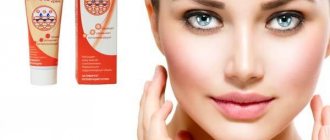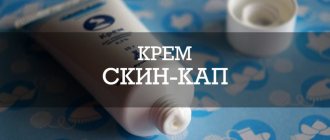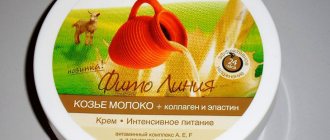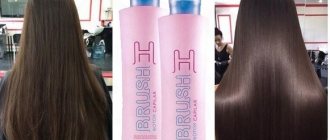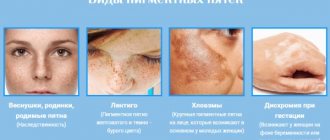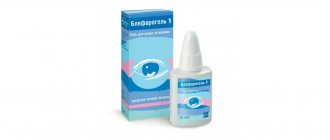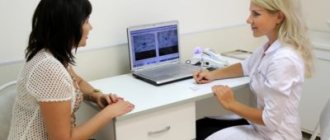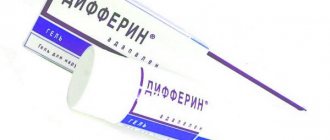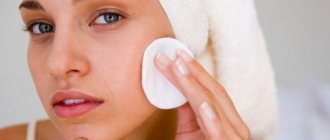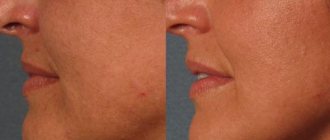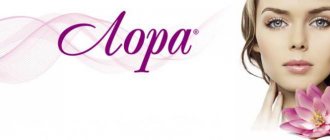From this article you will learn
- Skinoren instructions for use,
- gel or cream – which form is better,
- reviews of Skinoren from dermatologists.
The article was written by a specialist with higher medical education.
The drug Skinoren is a drug based on azelaic acid, which is used to treat acne, mild forms of acne, and also for the treatment of rosacea. The drug is produced well-known (Germany) and has 2 release forms - gel or cream for external use. These drugs are dispensed in pharmacies without a doctor's prescription, and according to the instructions for use, they can be used from 12 years of age.
Reviews from dermatologists about Skinoren are quite positive, however, according to international protocols for the treatment of acne, drugs with azelaic acid are only 2nd choice drugs (inferior in effectiveness to drugs from the group of topical retinoids). The latter include drugs such as Clenzit, Differin or Adaklin. However, drugs with azelaic acid also have their undeniable advantages, which we will discuss below.
What Skinoren gel looks like: photo
Indications for use –
- acne*,
- papulopustular form of acne (pimples)*,
- treatment of rosacea (gel only),
- treatment of chloasma (cream only).
* Please note that the use of drugs with azelaic acid is justified only for mild forms of acne and pimples. In addition, these drugs can be used to prevent new outbreaks of acne and pimples (after the full course of treatment with topical retinoids has been completed), i.e. used as maintenance therapy.
How much does Skinoren cost in pharmacies:
For Skinoren, the price in pharmacies depends on the size of the tube. Skinoren gel is available in tubes of 15 g, 30 g and 50 g, and their cost will be 600, 1200 and 1450 rubles, respectively. Skinoren cream is available only in 30 g tubes - at a price of 1200 to 1300 rubles. The cost is indicated for 2022. By the way, sometimes a 30 g tube of Skinoren cream or gel can be bought at a discount for about 950-1000 rubles.
In fact, it is expensive, considering that preparations with azelaic acid are somewhat inferior in effectiveness to topical retinoids, and also require significantly greater consumption of the drug. For example, Klenzit gel costs only about 800 rubles (for a 30 g tube), and Differin gel or cream costs 900 rubles (for a 30 g tube). Although from a logical point of view everything should be quite the opposite.
Medicinal composition and packaging
Skinoren (cream and gel)
created on the basis of the same active ingredient – azelaic acid. Both drugs are intended for external use. The difference between dosage forms lies in the concentration of the active substance, consistency and set of auxiliary components included in the composition. The result of exposure to azelaic acid:
- normalization of epithelization processes in hair follicles;
- suppression of pathogenic bacteria;
- decreased activity of melanocytes - cells that influence focal hyperpigmentation.
Gel Skinoren
– a jelly-like substance of whitish-yellow or white color, containing 15% of the active substance. Packaging in tubes of 15, 30 or 50 g is very convenient to use. Glycerin stearate, glycerides, cetostearyl alcohol, etc. are used as auxiliary components that determine consistency. Skinoren in the form of a cream contains 20% azelaic acid. The color of the substance is matte white. Packaging: 30 g tube. The composition additionally includes sodium hydroxide, lecithin, propylene glycol and other excipients. A higher concentration of the active substance does not mean an increase in efficiency, but only determines the specifics of application.
special instructions
Skinoren contains benzoic acid , a substance that causes minor irritation to the skin, mucous membranes and eyes, and propylene glycol , which can also cause skin irritation.
It is not recommended to allow the cream/gel to come into contact with the eyes, mouth or mucous membranes. If this does happen, the eyes, mouth or mucous membranes should be immediately rinsed with plenty of water. If eye irritation cannot be relieved, it is recommended to consult a doctor.
During the treatment of papulopustular rosacea, it is advisable not to use alcohol-containing detergents, as well as astringents, abrasives or exfoliants, and alcohol solutions.
Application of funds
Skinoren drugs are most often used in the treatment of acne and acne, as well as rosacea. The products are especially effective for preventing the appearance of post-inflammatory hyperpigmentation. Instructions for using any form of Skinoren are very simple:
- Preparing the skin for the procedure by cleansing (mild detergent or cosmetic).
- After the moisture has dried, the gel or cream is applied, lightly rubbing, in a thin layer to the affected areas of the skin.
- Hands are washed thoroughly with soap.
For a sustainable result, it is desirable that the course of treatment be at least 3 months, but the results of use are noticeable after 3-4 weeks. The procedures are carried out 2 times a day, usually in the morning and before bedtime. The possibility of hypersensitivity to the components of the drug should be taken into account. The dosage and duration of use are determined individually by the attending cosmetologist. Exceeding the amount may reduce the effect of application. Inadmissible contact of drugs with mucous membranes and eyes is eliminated by rinsing with running water.
The choice of dosage form depends on the type of skin pathology and skin type. For oily skin, it is better to use a gel, and for dry and normal skin, a cream. Skinoren cream is optimal for course therapy of hyperpigmentation, acne and seborrheic dermatitis, as confirmed by patient reviews. However, the versatility of the therapeutic effect of the drugs allows the use of any form for the treatment of skin diseases. The course of treatment should be at least a month.
As reviews show, Skinoren gel is most effective in the treatment of acne and rosacea. This dosage form has a faster effect because, due to its consistency, it penetrates the skin faster. The gel can be applied once a day, so it is ideal for maintaining a positive result in the treatment of the above diseases. To treat acne and pimples, the combined use of drugs is very often practiced. Courses of therapy can be repeated, if necessary, at intervals of 1-2 months. For hyperpigmentation, it is advisable to carry out repeated preventive courses of treatment using additional sunscreens.
Azelaic acid preparations are effective, but other agents are usually used for basic treatment of a specific skin disease. Medicines based on retinoids show the best effect on acne, and products with benzoyl peroxide are indispensable for treating acne. Skinoren combines perfectly with basic medications, enhancing their effectiveness and accelerating the healing process.
Skinoren: a new solution to an old problem
| Acne is a pathology that is not severe or life-threatening. However, we should not forget that it touches on a very important topic for every person - his appearance. Aesthetic problems reduce a person’s self-esteem, lead to psychological discomfort, and interfere with confident communication with others. Naturally, very often the search for drugs that can eliminate acne leads people to pharmacies and requires competent consultation with pharmacists and pharmacists. We bring to your attention a publication that will help you understand this problem. In order to choose the right drug for the treatment of acne, it is necessary to understand the main mechanisms of its occurrence and the main modern methods of treatment. Lyudmila Bolotnaya will help with this . |
Acne, or acne, is one of the most common diseases of the skin (sebaceous glands and hair follicles), affecting about 85% of people of puberty and active reproductive age. In the periods of 25–34 and 35–44 years, the incidence decreases sharply and amounts to 8% and 3%, respectively (Adaskevich I.P., 2000; Webster GF, 2002). Often these individuals have a burdened family history; the hereditary factor determines the structure and size of the sebaceous glands, the reaction and susceptibility of the skin appendages to neurovegetative influences (Cunliffe WJ, 2001).
In most cases, the rash goes away spontaneously by the age of 20, but sometimes the disease lasts for a long time - almost 5% of women and 3% of men aged 40–49 years report clinical manifestations of acne (E.R. Arabia, 2003). Acne on open areas of the body causes patients serious psychological distress. About 80% of teenagers believe that the most unattractive thing about a person is acne (Bassi R., 2000). The presence of rashes on visible areas of the skin causes dysmorphophobia (the idea of imaginary external ugliness).
The presence of inflamed pimples, pustules, comedones, spots and scars, a greasy, untidy appearance of the skin causes difficulties in communication and personal life, career, reduces self-esteem, and often leads to complete isolation. In stressful situations, patients, especially women, pick and squeeze out acne, which further worsens the appearance of the skin due to inflammation, subsequent formation of scars and age spots (Masyukova S.A., 2002; Plewig G., 2000). Neurotic conditions that develop with severe cosmetic skin defects in women indirectly affect the state of the reproductive system.
In the pathogenesis of acne, the main role belongs to the hormonal factor (hyperandrogenism) and genetic predisposition, which lead to hypertrophy and increased functioning of the sebaceous glands, follicular hyperkeratosis, activation of the microbial flora and subsequent inflammation (Ogurtsova A.N. 2004; Monakhov S.A., 2005 ; Zaba R., 2001).
The key link is to slow down the rejection of epithelial cells lining the lumen of the follicular canal of the sebaceous gland, which leads to retention hyperkeratosis. Both processes (follicular hyperkeratosis and increasing adhesion of corneocytes) lead to blockage of the gland duct with horny masses and the formation of comedones. With hyperkeratosis of the epidermal part of the follicular canal, open comedones are formed. With hyperkeratosis of the deep part, the outlet of the follicular canal does not expand, but is filled with sebum and detritus, forming closed comedones.
Blockage of the sebaceous gland creates optimal conditions for the rapid proliferation of anaerobic flora (Propionbacterium acnes)
and the development of an inflammatory reaction with the subsequent formation of inflammatory elements (papules, pustules, nodes and cysts) (Adaskevich I.P., 2000; Danilova A.A., Sheklakova M.N. 2001; Samgin M.A., Monakhov S.A. ., 2003). In parallel, the increased level of androgens causes changes in endocrine-dependent organs and organs of the reproductive system, forming a pathological self-sustaining system (Rogovskaya S.I., 2003).
Acne manifests itself in various clinical forms. In practice, the most convenient, in our opinion, for making a diagnosis and determining treatment tactics taking into account the clinical manifestations of the disease is the following classification (Plewig G., Kligman MA, 2000):
1. Childhood acne:
- neonatal acne;
- infant acne;
- acne conglobata of infants;
2. Juvenile acne:
- comedonal acne;
- papular and papulopustular acne;
- acne conglobata;
- acne inversa;
- acne fulminans;
- hard persistent swelling of the face due to acne;
- mechanical acne.
Depending on the severity, a mild degree is distinguished - less than 10 comedones and papulopustular elements in a limited area (usually the face); moderate degree - small amount - up to 20 comedones and 25 papulopustular elements, 2 or more topographic areas are involved in the process, there are psychosocial disorders; severe degree - numerous comedones (more than 21) and papulopustular (more than 26), indurative and conglobate elements, widespread forms, severe psychosocial disorders (Suvorova K.N., 1999).
The variety of pathogenetic factors causes difficulties in the treatment of acne. The problem of acne therapy remains relevant, despite the availability of a large number of drugs for systemic and external use (Arabiiskaya E.R., 2003; Samgin M.A., 2003; Gushchina N., 2005; Zaba R., 2001). The opinion that existed in the past that acne will go away on its own with age and that there is no need to waste effort on treating it now sounds simply absurd.
Today, vast experience in treating the disease has been accumulated and an algorithm for pathogenetic treatment has been developed depending on the form of the disease, severity, type and number of acne elements, psychosocial status and gender of the patient, concomitant pathology, as well as the effectiveness of treatment.
When treating acne, it is necessary to reduce the effect of androgens on the sebaceous gland, inflammation, and skin contamination with Propionbacterium acnes
and other microorganisms, normalize its mitotic activity.
Properly selected medical and cosmetic care products (lotions, moisturizing creams, scrubs, etc.) are also of great importance. At the same time, a remedy that would forever relieve the patient of all manifestations of acne remains a dream. Doctors and patients turn with hope to every new product that appears on the market, which later often turns into disappointment. Meanwhile, it is much more expedient to understand the mechanisms of action of each drug and find a place for it in complex acne therapy and subsequent skin rehabilitation. When choosing treatment for acne, one should also take into account the possibility of preventing secondary changes in the skin, primarily post-inflammatory pigmentation and atrophic scars.
General principles of acne treatment include: retinoids, antibacterial and hormonal therapy, non-steroidal anti-inflammatory drugs, vitamins, sedatives, physiotherapy (Adaskevich I.P., 2000; Masyukova S.A., 2002). Topical agents are often quite effective for mild forms of acne and remain an important adjunct to systemic therapy for more severe acne.
For the treatment of mild (comedonal) and moderately severe (papulopustular) acne without pronounced inflammatory manifestations, as well as to prevent further transformation of comedones into inflammatory elements, keratolytics are prescribed. They are also called comedolytics (this does not mean a lysing effect on the contents of comedones, but one that leads to a decrease in cohesion and accelerates their desquamation).
Keratolytics include derivatives of retinoic acid, azelaic acid, adapalene - a derivative of naphthoic acid with a retino-like effect, benzoyl peroxide α-hydroxy acid.
The use of retinoids solves several problems - reducing sebum production and inflammation, preventing the appearance and elimination of comedones and scars. With external treatment with retinoids, peeling and slight redness may occur.
Retinoids should not be used in summer due to the risk of pigmentation. The use of both internal and external retinoids must be excluded and cannot be combined with ultraviolet irradiation, drugs with keratolytic and exfoliating effects, or exfoliating cosmetic procedures (scrub, peeling).
Retinoid drugs have a number of side effects. The most serious of them are teratogenicity and embryotoxicity. In this regard, women of childbearing age are prescribed systemic retinoids with reliable contraception and a negative pregnancy test. During the 1st–2nd week of external therapy, most patients experience an exacerbation reaction, expressed in redness, moderate itching, dry lips, cracks in the corners of the mouth, and peeling of the skin. With systemic administration of retinoids, dry nasal mucosa, nosebleeds, conjunctivitis, urethritis, increased levels of transaminases and lipids in the blood, and increased sensitivity of the skin to sunlight are sometimes observed (Svyatenko T.V., 2005; Bassi R., 2000).
Sex hormone therapy is possible in women with moderate to severe acne (Monakhov S.A., 2005). For treatment, Diane-35, Yarina can be used, which can be taken simultaneously with local agents. To achieve a good result, oral contraceptives are prescribed for at least 6 menstrual cycles.
One of the components of complex therapy is long-term (1–3 or more months) oral use of antibacterial drugs (tetracycline, erythromycin). It is indicated for moderate forms, damage to a large area of skin, and a predominance of pustules.
| SKINOREN significantly reduces the number of inflamed and non-inflamed acne, and it not only affects superficial papules, but also contributes to the disappearance of deep lesions (nodular elements) |
However, treatment with antibacterial drugs may be accompanied by inhibition of intestinal autoflora with the development of dysbiosis, candidiasis and suppression of the phagocytic component of immunity, which will lead to the development of immunological deficiency. Tetracyclines are contraindicated in case of concomitant fungal diseases, pregnancy (III trimester), liver dysfunction, leukopenia, kidney diseases, children under 8 years of age, and have a photosensitizing effect. Unfortunately, resistance of microorganisms to drugs of this group quickly develops and when re-prescribed they are rarely effective. Complete cure is not always achieved and is not permanent, so taking antibacterial drugs is not justified in mild forms of acne (Driscoll MS, 1998).
The administration of external drugs that have antimicrobial and anti-inflammatory activity, that is, containing antibiotics, as well as the administration of antibacterial drugs internally, can cause the development of antibiotic-resistant strains of microorganisms, so their re-prescription is often ineffective. Resistance of Propionbacterium acnes
to commonly used antibiotics was observed in 60% of patients. The increase in resistance depends on the duration of therapy; resistance to erythromycin develops more often.
The drug containing zinc hyaluronate has a healing and antimicrobial effect. It can be used for mild forms and a small number of rashes, since its effectiveness is low. There may be a burning sensation and redness of the skin where the gel is applied.
One of the effective and safe medications for the treatment of mild to moderate acne is azelaic acid. Now the drugs that contain it - SKINOREN cream and gel - are used in world practice for the treatment of acne, seborrheic dermatitis, follicular hyperkeratosis, pathological hyperpigmentation, rosacea (Masyukova S.A., 2002).
Azelaic acid belongs to natural dicarboxylic acids, natural products. Being a competitive inhibitor of various oxygen-reducing enzymes, azelaic acid has the ability to inhibit the biosynthesis of cellular proteins, exhibits antioxidant activity, selectively penetrating into activated inflammatory and neoplastic cells. The biological, tissue effects of azelaic acid are manifested in the suppression of the development of Propionibacterium acnes
, inhibition of keratinocyte proliferation, acceleration of comedonal lysis, normalization of keratinization processes and the formation of fatty acids in hair follicles, inhibition of the growth and activity of abnormal melanocytes.
SKINOREN significantly reduces the number of inflamed and non-inflamed acne, and it not only affects superficial papules, but also contributes to the disappearance of deep lesions (nodular elements).
However, it should be remembered that acne is a disease that responds slowly to therapy. Therefore, the use of SKINOREN should be long-term (8–16 weeks); a clear clinical improvement is observed after 1 month. In some cases, at the beginning of therapy, local skin irritation (redness, peeling, burning) is possible, which usually resolves during treatment.
In recent years, the second generation of azelaic acid preparations - 15% gel - has been used for use in dermatological practice. The hydrogel is non-toxic, does not cause photosensitivity and addiction, provides a more effective concentration of azelaic acid and rapid penetration of the active substance into the skin. The drug can be used during pregnancy and breastfeeding.
SKINOREN gel has numerous cosmetic benefits and is ideal for use in summer, can be applied under makeup, is quickly absorbed and does not leave an oily sheen, has a pleasant consistency, and perfectly moisturizes the skin. In addition, this medicine has a cooling effect when applied to the skin, which is an important factor for patients with rosacea. With regular use of SKINOREN gel, a stable and long-lasting effect is ensured. For the convenience of patients, it is presented in two types of packaging: tubes of 5 g and 30 g.
For mild severity, SKINOREN cream or gel is used as monotherapy; for moderate severity, it is used in complex therapy. SKINOREN can be used at any age, at any time of the year, including for the treatment of post-acne pigmentation.
Due to its favorable therapeutic effect (keratolytic, antimicrobial, anti-inflammatory) and mild side effects (erythema, burning, peeling) or their absence (bacterial resistance, photosensitivity), SKINOREN takes its rightful place in the arsenal of acne treatments, helps eliminate rashes and rehabilitate the skin. .
Thus, timely and adequate prescription of various medications, taking into account the skin type, mechanism of action and possible side effects, allows for staged treatment targeting various stages of pathogenesis, obtaining good clinical results, and avoiding the development of psycho-emotional disorders in patients with different clinical forms of acne. o
Press service of “APTEKA Weekly”
Therapeutic effect of drugs
The mechanism of skin diseases that are treated with azelaic acid preparations has long been revealed and understood. The fatty secretion produced by the sebaceous glands enters the skin surface through the lumen of the hair follicles and protects it. Due to various processes, skin pores become clogged with fat and dead epithelium, which can lead to the proliferation of pathogenic bacteria and the occurrence of pathology.
Skinoren effectively inhibits the growth of bacteria and staphylococci on the skin. Reducing the inflammatory process in turn prevents the formation of new blackheads or acne. Effectively reducing the proliferation of epidermal cells reduces and normalizes the number of keratinized skin scales. In essence, the gel and cream accelerate the resorption of sebaceous plugs in the pores of the skin, melting them.
Blocking with Skinoren drugs the excessive production of melanin pigment, which directly affects skin color, allows you to effectively combat age spots. With regular treatment, areas with darkened skin turn pale and become almost invisible.
Neutralizing the development of acne, rosacea and other skin pathologies using a cream or gel is very effective, which is confirmed by many clinical applications. Despite deep penetration into the skin, azelaic acid practically does not enter the blood, so the use of the drugs is completely harmless.
Pharmacodynamics and pharmacokinetics
The effectiveness of Skinoren in the treatment of acne is due to the antibacterial properties of azelaic acid and the ability of the substance to have a direct effect on follicular (hair) hyperkeratosis .
In in vivo and in vitro models, it inhibits the proliferation of keratinocytes (the main cells of the epidermal layer) and normalizes the terminal processes of epidermal cell acne .
With the use of the drug, there is a significant decrease in the density of colonies of propionibacteria acne , as well as a significant decrease in the concentration of free fatty acids in lipids on the surface of the skin (due to this, the oiliness of the skin decreases).
The mechanism of action of azelaic acid on the pathogenic phenomena that occur with rosacea has not been precisely established. Several studies have shown that in in vitro and ex vivo models, the substance is able to stop the inflammatory process by reducing the production of reactive oxygen metabolites (its free-radial forms) and the formation of anti-inflammatory agents.
Azelaic acid has a dose- and time-dependent inhibitory effect on the growth and viability of abnormal melanocytes .
After local application of the drug, azelaic acid penetrates into all layers of the skin, and the substance penetrates into damaged skin an order of magnitude faster than into intact skin. In total, after a single use of 5 grams of 20% Skinoren cream (equivalent to 1 gram of azelaic acid), no more than 3.6% of the dose is absorbed through the skin.
Clinical studies of the use of the product for acne have shown that the rate of absorption of azelaic acid for the cream and gel is the same.
From the body, the substance is partially eliminated with urine in its pure form, the remainder undergoes a cycle of degradation reactions and breaks down into dibasic carboxylic acids with a shorter chain length. Beta-oxidation products of azelaic acid are also found in urine.
Benefits of Skinoren
There is a wide variety of drugs based on azelaic acid that are successfully used to treat skin pathologies. The most popular analogues of Skinoren in our country are Azogel and Azelik gels (Russia), as well as Azix-derm (India) and Acne-derm (Poland) creams. The concentration of the active component coincides with the German development, but the composition of the excipients is somewhat different.
The main advantages of the drugs over analogues:
- Milder effect (does not cause excessive dryness and irritation).
- There is no increase in sun sensitivity, so there is no need to combine with sunscreens.
- Can be used both for the treatment and prevention of skin pathologies.
- Easy to use.
- Lower price.
It should be noted that there are cheaper analogues, but their effectiveness, according to experts and patient reviews, is much less.
Skinoren during pregnancy and breastfeeding
It is not known exactly how safe azelaic acid preparations are for pregnant women. In studies conducted on laboratory animals, no direct or indirect negative effects on the course of pregnancy, embryogenesis, intrauterine development of the fetus, the course of labor and postnatal development were revealed.
Despite the absence of direct contraindications for use in the instructions, the cream and gel should be used with caution during pregnancy.
Newborn children should not come into contact with skin/breast treated with Skinoren. There is no reliable data on whether azelaic acid can penetrate into the milk of a nursing woman.
However, in vitro experiments carried out using the equilibrium dialysis technique showed that this possibility cannot be completely excluded. For this reason, nursing women are advised to use the drug with caution and with the approval of a doctor.
Contraindications and side effects
Are there any restrictions on the use of Skinoren drugs? The instructions for use clearly stipulate that the only obstacle may be individual hypersensitivity or the presence of allergic reactions. Indirect evidence of the safety of the products can be the possibility of their use even during pregnancy. Before using the products, it makes sense to find out your skin type from your doctor.
Side effects occur quite rarely, are moderate in nature and decrease with therapy. Main types of manifestations during treatment:
- dryness or slight numbness of the skin;
- the appearance of slight swelling with rosacea;
- itching or burning in the area where the cream or gel is applied;
- skin peeling;
- the appearance of spots;
- feeling of discomfort;
- allergic reactions;
- urticaria in the area where the drug is applied;
- worsening of other diseases.
If at least one of the above manifestations occurs, you should temporarily reduce the dose of the drug and be sure to consult your doctor. The reasons for the manifestation can be very diverse. Skinoren cream is not recommended to be applied after warming procedures - baths, saunas, etc.
Side effects
Skinoren does not provoke the development of systemic side effects. During clinical studies, only local reactions to treatment with the drug were identified. Typically, symptoms associated with the use of a gel or cream are mild or moderate; often their number decreases with continued therapy.
Most often in clinical studies, itching, burning sensation and pain at the site of application of the ointment were recorded.
paresthesia at the site of application of the cream/gel may be observed In patients with rosacea local swelling of the dermis at the site of application cannot be excluded
In patients with acne, in a number of cases (with a frequency from ≥1/1000 to <1/100), phenomena such as contact dermatitis , peeling of the skin, erythema , a feeling of warmth and discoloration of the skin at the site of application of the drug were noted.
With a similar frequency, the following were recorded with rosacea : contact dermatitis , acne , discomfort in the treated area of skin, erythema , urticaria .
Reviews
Excluding cases of skin hypersensitivity, Skinoren gel and cream have excellent patient reviews. Many users note that these drugs helped in many cases when other remedies were powerless. There are complaints about the high cost of drugs, but generally people understand that the effectiveness of treatment is worth the money spent. Reviews mainly concern the treatment of acne and pimples, but good results are also noted by those who have used the products to eliminate problems with skin pigmentation.
Skinoren price, where to buy
How much does Skinoren for acne cost in Russian pharmacies?
The average price of Skinoren gel on the Russian pharmaceutical market: for a 15 g tube - from 480 rubles; for a tube of 30 g - from 845 rubles; for a tube of 50 g - from 1170 rubles.
The price of acne cream in St. Petersburg and Moscow varies from 845 to approximately 1,500 rubles.
Cost of Skinoren for acne in Ukrainian pharmacies
The price of Skinoren gel in Ukraine is from 85 UAH. The price of Skinoren cream in pharmacies in large cities (for example, in Kharkov or Kiev) is from 240 UAH.
Price of the drug in Belarus
You can buy gel in Belarus for an average of 65,000 Bel. rubles per tube of 5 grams. The cost of a 30-gram tube is from 160,000 BYN. rubles The average price of ointment (cream) is 170,000 BYN. rubles
- Online pharmacies in RussiaRussia
- Online pharmacies in UkraineUkraine
- Online pharmacies in KazakhstanKazakhstan
ZdravCity
- Skinoren gel 15% 50g Bayer Healthcare Manufacturing S.R.L.
RUB 1,480 order - Skinoren gel 15% 15g Bayer Healthcare Manufacturing S.R.L.
RUR 789 order
- Skinoren gel 15% 30g Bayer Healthcare Manufacturing S.R.L.
RUB 1,137 order
- Skinoren cream 20% 30 gLEO Pharma Manufacturing Italy S.r.l.
RUB 1,243 order
Pharmacy Dialogue
- Skinoren gel (tube 15% 50g) Bayer
RUB 1,485 order
- Skinoren gel tube 15% 30gBayer
RUR 1,118 order
- Skinoren cream (tube 20% 30g)Bayer
1122 rub. order
- Skinoren gel tube 15% 50gIntendis Manufakturing
RUB 1,481 order
- Skinoren gel tube 15% 15gIntendis Manufakturing
RUR 738 order
show more
Pharmacy24
- Skinoren 20% 30 g cream Intendis Manufacturing S.p.A., Italy/ Bayer Healthcare Manufacturing S.R.L., Italy
305 UAH.order - Skinoren 15% 30 g gel Bayer Healthcare Manufacturing S.R.L., Italy
306 UAH. order
PaniPharmacy
- Skinoren cream Skinoren cream 20% 30g Italy, Bayer Healthcare Manufacturing
312 UAH. order
- Skinoren gel Skinoren gel 15% 30g Italy, Bayer Healthcare Manufacturing
328 UAH. order
show more
